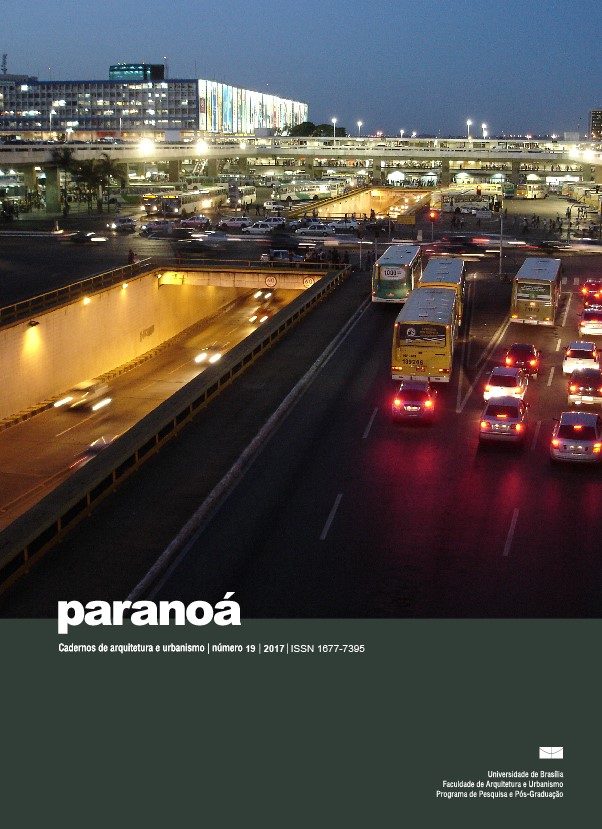Qualidade e percepção do ambiente construído na saúde mental de médicos residentes
DOI:
https://doi.org/10.18830/issn.1679-0944.n19.2017.05Keywords:
Quality of the built environment, Health psychology, Resident doctor, Imaging sectorAbstract
This research will discuss the relationship between the quality of the built environment, with only artificial systems (lighting and heat control), and resident doctors’ mental health in a Radiology department, which has specific building design requirements. To establish this correlation the Radiology Departments´ environment was evaluated (measuring variables of the built environment), environmental perception (with the application of a specific questionnaire) and psychological evaluation identifying the existence of and the level of mental illness such as stress, anxiety and depression. It was concluded that among the three resident doctors’ groups, the students from the first group suffered expected psychological effects associated with the built environment; the ones from the second group demonstrated psychological effects typical of resident doctors’ but have adapted to the built environment; and the students from the third group demonstrated values within the expected range for the activities performed. We also identified low illuminance and temperature, necessary to the activities. Thus, this research also added to the state-of-art and database, new information about the environment’s influence on users’ perception, fomenting to a development of recommendations aiming the hospital environment quality.
Downloads
References
ASSOCIAÇÃO BRASILEIRA DE NORMAS TÉCNICAS (ABNT). NBR ISO/CIE 8995:1 ”“ Iluminação de ambientes de trabalho Parte 1: Interior. Rio de Janeiro: ABNT, 2013.
ASSOCIAÇÃO BRASILEIRA DE NORMAS TÉCNICAS (ABNT). NR 17 ”“ Ergonomia. Rio de Janeiro: ABNT, 2007.
BAKER, N.; STEEMERS, K. Daylight Design of Buildings: A Handbook for Architects and Engineers. EUA: Routledge, 2002.
BATIZ, E.C.; GOEDERT, J.; MORSCH, J.J.; JUNIOR, P.K.; VENSKE, R. Avaliação do conforto térmico no aprendizado: estudo de caso sobre influência na atenção e memória. Revista Produção19: 477-488, 2009.
BECK A.T.; STEER, R.A.; BROWN, G.K. Manual for the Beck Depression Inventory-II. EUA: Psychological Corporation, 1996.
BECK, A. T. Depression: Causes and Treatment. Philadelphia: University of Pennsylvania Press, 2006.
BOYCE, P. Human factors in lighting. 2ªed. Londres: Taylor & Francis, 2003.
BRASIL. Ministério da Saúde. Manual do Residente. Brasília: Ministério da Saúde, 2002. Disponível em <http://portal.mec.gov.br/index.php?option=com_content&id=12263&Itemid=507>. Acesso em mai, 2013.
BREVIGLIERO, E.; POSSEBON, J.; SPINELLI, R. Higiene ocupacional: agentes biológicos, químicos e físicos. 5ª ed. São Paulo: Editora SENAC São Paulo, 2006.
BUYSSE, D.J.; REYNOLDS III, C.F.; MONK, T.H.; BERMAN, S.R.; KUPFER, D.J. The Pittsburgh Sleep Quality Index: a new instrument for psychiatric practice and research. Psychiatric Research 28: 193-213, 1989.
CARLSON, N.R. Fisiologia do comportamento. 7ª ed. Barueri/SP: Editora Manole, 2002.
FANGER, P.O. Thermal comfort. New York: McGraw-Hill Book Company, 1970.
GOLDBERG, D.P. The detection of psychiatric illness by questionnaire: a technique for the identification and assessment of non-psychotic psychiatric illness. Trad. Luiz Pasquali, Valdiney Veloso Gouveia, Wagner Bandeira Andriola, Fabio jesus Miranda, Andre Luiz Moraes Ramos. São Paulo: Laboratório em Avaliação e Medida ”“ LABPAM/ Editora Casa do Psicológo, 1996.
Graphpad Software Inc. GraphPad Prism v.6.0. California: Graphpad Software Inc., 2014.
GUZOWSKI, M. Daylighting for sustainable design. New York: McGraw Hill, 1999.
IIDA, I. Ergonomia: projeto e produção. 2ª ed. São Paulo: Editora Blucher, 2005.
International Business Machines (IBM). Statistical Package for Social Science ”“ SPSS Statistics. Versão 22.0. Chicago: IBM, 2013.
International Organization for Standardization (ISO) ISO 10551 ”“ Ergonomics of the thermal environment - Assessment of the influence of the thermal environment using subjective judgement scales. Genebra: ISO, 1995.
International Organization for Standardization (ISO) ISO 7726 ”“ Thermal environments: Instruments and methods for measuring physical quantities. Genebra: ISO, 1998.
JOHNS, M.W. A new method for measuring daytime sleepiness: the Epworth Sleepiness Scale. Journal of Sleep 14: 540-545, 1991.
LIPP, M.N. ISSL ”“ Inventário de Sintomas de Stress para Adultos de Lipp. 3ª ed. São Paulo: Editora Casa do Psicólogo, 2005.
MICROSOFT. Microsoft Excel 2010. EUA: Microsoft Corporation, 2010.
NELSON, D.; AYLOR, B.; NELSON, R. Development of a questionnaire to examine worker risk perception of noise and use of hearing protection devices. American Industrial Hygiene Conference & Exposition (AIHce), Toronto, 1999. Anais. Toronto: AIHce, 1999.
RABINOWITZ, P. Noise-induced hearing loss. American Family Physician 61: 2749-2756, 2000.
RUNDMO, T. Associations between risk perception and safety. Safety Science 24: 197-209, 1996.
SASSI, P. Strategies for sustainable architecture. New York: Taylor&Francis, 2006.
SPIELBERGER, C.D.; GORSUCH, R.L.; LUSHENE, R.E. IDATE ”“ Inventário de Ansiedade de Traço-Estado. Trad. Angela M. B. Biaggio e Luiz Natalicio. 2ª ed. Rio de Janeiro: Centro Editor de Psicologia Aplicada, 2003.
ZUMTOBEL ELI-LENI Calculator.Versão 3.2.0. Austria: Zumtobel Lighting, 2010.
ZUMTOBEL. The lighting handbook. Austria: Zumtobel Lighting, 2008.
Downloads
How to Cite
Issue
Section
License
Autores que publicam nesta revista concordam com os seguintes termos:
- Autores mantém os direitos autorais e concedem à revista o direito de primeira publicação, com o trabalho simultaneamente licenciado sob a Licença Creative Commons Attribution que permite o compartilhamento do trabalho com reconhecimento da autoria e publicação inicial nesta revista. http://creativecommons.org/licenses/by/4.0
- Autores têm autorização para assumir contratos adicionais separadamente, para distribuição não-exclusiva da versão do trabalho publicada nesta revista (ex.: publicar em repositório institucional ou como capítulo de livro), com reconhecimento de autoria e publicação inicial nesta revista.
- Autores têm permissão e são estimulados a publicar e distribuir seu trabalho online (ex.: em repositórios institucionais ou na sua página pessoal) a qualquer ponto antes ou durante o processo editorial, já que isso pode gerar alterações produtivas, bem como aumentar o impacto e a citação do trabalho publicado (Veja O Efeito do Acesso Livre).















